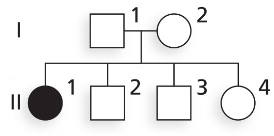The following pedigree is characteristic of an inherited condition known as male precocious puberty, where affected males show signs of puberty by age 4. Propose a genetic explanation of this phenotype.
Table of contents
- 1. Introduction to Genetics51m
- 2. Mendel's Laws of Inheritance3h 37m
- 3. Extensions to Mendelian Inheritance2h 41m
- 4. Genetic Mapping and Linkage2h 28m
- 5. Genetics of Bacteria and Viruses1h 21m
- 6. Chromosomal Variation1h 48m
- 7. DNA and Chromosome Structure56m
- 8. DNA Replication1h 10m
- 9. Mitosis and Meiosis1h 34m
- 10. Transcription1h 0m
- 11. Translation58m
- 12. Gene Regulation in Prokaryotes1h 19m
- 13. Gene Regulation in Eukaryotes44m
- 14. Genetic Control of Development44m
- 15. Genomes and Genomics1h 50m
- 16. Transposable Elements47m
- 17. Mutation, Repair, and Recombination1h 6m
- 18. Molecular Genetic Tools19m
- 19. Cancer Genetics29m
- 20. Quantitative Genetics1h 26m
- 21. Population Genetics50m
- 22. Evolutionary Genetics29m
2. Mendel's Laws of Inheritance
Pedigrees
Problem 47e
Textbook Question
The accompanying pedigree shows a family in which one child (II-1) has an autosomal recessive condition. On the basis of this fact alone, provide the following information.

What is the chance that among the three children in generation II who have the dominant phenotype, one of them is AA and two of them are Aa? (Hint: Consider all possible orders of genotypes.)
 Verified step by step guidance
Verified step by step guidance1
Step 1: Understand the inheritance pattern. The condition is autosomal recessive, meaning individuals with the genotype 'aa' have the condition, while individuals with 'AA' or 'Aa' have the dominant phenotype. Parents of the affected child (II-1) must both be carriers (Aa).
Step 2: Determine the probabilities for each genotype in the offspring. Using a Punnett square for two heterozygous parents (Aa x Aa), the probabilities are: 1/4 for 'AA', 1/2 for 'Aa', and 1/4 for 'aa'.
Step 3: Focus on the three children in generation II who have the dominant phenotype. Since 'aa' individuals are excluded, the remaining genotypes are 'AA' and 'Aa'. The probability of being 'AA' is 1/3, and the probability of being 'Aa' is 2/3 (adjusted for the exclusion of 'aa').
Step 4: Calculate the probability of one child being 'AA' and two children being 'Aa'. This involves using the multinomial probability formula: P = (n! / (k1! * k2!)) * (p1^k1) * (p2^k2), where n is the total number of children, k1 and k2 are the counts of each genotype, and p1 and p2 are their respective probabilities.
Step 5: Account for all possible orders of genotypes. Since the order of the children matters, there are multiple arrangements (e.g., 'AA, Aa, Aa', 'Aa, AA, Aa', etc.). Multiply the probability calculated in Step 4 by the number of possible arrangements (which can be determined using permutations).
 Verified video answer for a similar problem:
Verified video answer for a similar problem:This video solution was recommended by our tutors as helpful for the problem above
Video duration:
2mPlay a video:
Was this helpful?
Key Concepts
Here are the essential concepts you must grasp in order to answer the question correctly.
Autosomal Recessive Inheritance
Autosomal recessive inheritance occurs when a trait is expressed only when an individual has two copies of the recessive allele (aa). Carriers, who have one dominant allele (A) and one recessive allele (a), do not express the condition but can pass the recessive allele to their offspring. Understanding this inheritance pattern is crucial for analyzing the genotypes of individuals in a pedigree.
Recommended video:
Guided course

Autosomal Pedigrees
Genotype Probability
Genotype probability involves calculating the likelihood of specific genetic combinations occurring in offspring based on parental genotypes. In this scenario, we need to determine the probability of having one child with the homozygous dominant genotype (AA) and two with the heterozygous genotype (Aa) among the children with a dominant phenotype. This requires applying the principles of probability to genetic outcomes.
Recommended video:
Guided course

Probability
Order of Genotypes
The order of genotypes refers to the different arrangements in which specific genotypes can occur among a set of individuals. In this case, we must consider all possible sequences of one AA and two Aa children, as the arrangement affects the overall probability. This concept is essential for calculating the total probability of the desired genotype distribution.
Recommended video:
Guided course

Gamete Genotypes
Related Videos
Related Practice
Textbook Question
500
views


